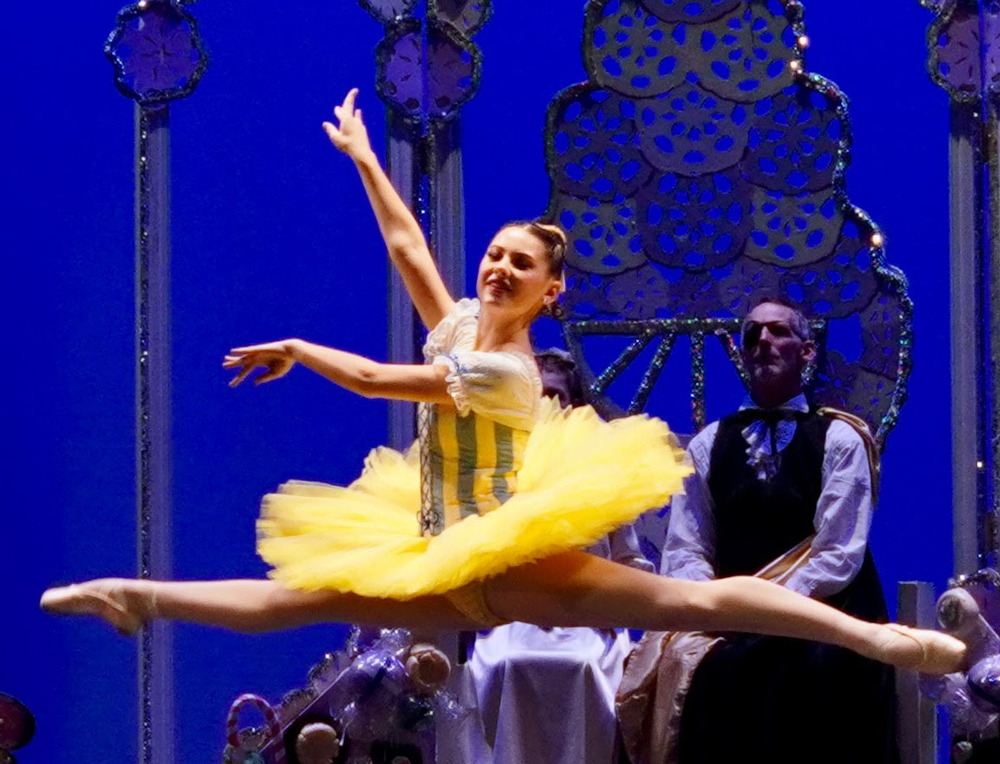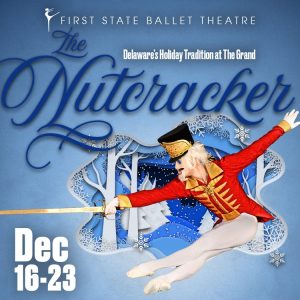By Denny Dyroff, Entertainment Editor, The Times

Brandywine Ballet Company
With all the holiday craziness going on all around you – crowded stores, long waits at restaurants, heavy vehicular traffic, ridiculous lines at checkouts, Santa showing up everywhere and, of course, guys with cauldrons ringing bells to solicit donation everywhere you turn – it’s a normal reaction to seek respite.
One great way to avoid the insanity and find some peaceful moments is to head inside and attend a live show. Whether it’s theater, holiday spectaculars, ballet performances or musical, it’s all good.
There are many holiday activities which have become yearly rituals for area families – decorated houses, exchanging presents around the Christmas tree, holiday parties with cookies and egg nog, listening to Christmas carols and, of course, shopping at malls (or Amazon).
Another popular family activity is attending a live performance of the classic ballet, “The Nutcracker.”
“The Nutcracker” has been an annual tradition for the Brandywine Ballet Company (www.brandywineballet.org) since 1985.
It’s back again for another run this weekend from December 15-17 at West Chester University’s Emilie K. Asplundh Concert Hall (700 South High Street, West Chester).
Audiences are invited to celebrate the season with Tchaikovsky’s timeless score and be transported to the magical Land of Sweets. There, they can join Clara and the Sugar Plum Fairy on the journey of a dream.
This performance, which is one of Chester County’s signature holiday events, features original, traditional choreography by David Kloss and Donna L. Muzio.
The impressive choreography has been integrated with new choreographic elements by Resident Choreographer, Nancy Page and Tim Early.
Brandywine Ballet’s five-performance run of “The Nutcracker” has continued to delight audiences each year for more than four decades with a tour de force of beauty and elegance.
The ballet is based on the timeless tale “The Nutcracker and The Mouse King” and set to a score by Peter Ilyich Tchaikovsky. With its familiar music and energetic dance numbers, “The Nutcracker” is a show that appeals to audiences of all ages.
The Brandywine Ballet’s “The Nutcracker” is a professional show that features skilled dancers, lively choreography, colorful costumes and sparkling sets.
Performances of the ballet are scheduled for December 15 at 6 p.m., December 16 at 11 a.m. and 5 p.m. and December 17 at 11 a.m. and 3 p.m.
Tickets are $30, $40 and $50.
 The Grand Opera House (818 North Market Street, Wilmington, Delaware, 302-652-5577, www.thegrandwilmington.org) is hosting five performances of “The Nutcracker” by the First State Ballet Theatre on December 16, 17, 22 and 23.
The Grand Opera House (818 North Market Street, Wilmington, Delaware, 302-652-5577, www.thegrandwilmington.org) is hosting five performances of “The Nutcracker” by the First State Ballet Theatre on December 16, 17, 22 and 23.
“The Nutcracker” is a ballet in two acts that had its premiere on December 18, 1892 at the Mariinsky Theatre, St. Petersburg.
The First State Ballet’s “The Nutcracker” features music by Pyotr Ilyich Tchaikovsky and choreography byPasha Kambalov and Kristina Kambalov after Lev Ivanov and Marius Petipa.
In the ballet, the Stahlbaums and their children Marie and Fritz are hosting their annual Christmas party. The mysterious Herr Drosselmeyer enters and entertains the children.
Drosselmeyer later appears disguised as a magician and presents a puppet show, followed by three life-size dancing dolls, to the delight of the guests.
The children begin to open gifts and Drosselmeyer presents his gift of a beautiful nutcracker to Marie. Marie admires it more than all the other toys. Fritz wants to play with the new doll; he pulls it away from Marie and throws it on the floor. Marie is heartbroken, but Drosselmeyer quickly repairs the nutcracker.
As the evening grows late, the guests depart and the Stahlbaum family retires for the evening. Marie comes downstairs to steal one last glance at her nutcracker under the Christmas tree. She falls asleep.
In a dream she sees the drawing room. A mouse scurries out of a hole, and then mice scamper out from everywhere. The mice try to take the nutcracker from Marie until the Mouse King enters. Marie is terribly frightened and hides behind a chair.
Suddenly her nutcracker appears life-size. Overcoming her fear, she runs up to him. The Nutcracker leads a regiment of soldiers to defend Marie. The Mouse King is defeated and disappears with his army.
Drosselmeyer transforms Marie into a lovely maiden and the Nutcracker into a handsome prince. Together, they set off on a journey to the Land of Snow where they are welcomed by dancing snowflakes.
In Act II, Marie and the prince arrive in the Land of Sweets and the festivities begin. First comes Chocolate, then Coffee and Tea, followed by Honey Cake, Marzipan and Gingerbread, Gumdrops and the Waltz of the Flowers. Marie and the prince dance merrily with the rest.
At last the wonderful dream is over and Marie awakens.
Video link for First State Ballet’s “The Nutcracker” — https://youtu.be/FuZ4u4NdXI4.
Performances are scheduled for 2 and 7 p.m. on December 16, 2 p.m. on December 17, 7 p.m. on December 22 and 2 p.m. on December 23.
Ticket prices for the shows at The Grand Opera House range from $24.99-$67.
The Philadelphia Ballet’s annual production of “George Balanchine’s The Nutcracker” is one of the most cherished—and longest running—family holiday traditions for families in the region.
For many, a visit to Philadelphia to enjoy the lavish presentation by the world-famous Philadelphia Ballet is an integral part of the holiday season.
This year’s production, which is running now through December 30 at the Academy of Music (Broad and Locust streets, Philadelphia, 215-893-1999, www.philadelphiaballet.org), is in the fifth decade of staging of the classic ballet.
The ballet is based on E.T.A. Hoffman’s tale “The Nutcracker and The Mouse King” and set to a score by Peter Ilych Tchaikovsky.
Featuring lively dances, colorful costumes and elaborate sets, “The Nutcracker” is a production that appeals to audiences of all ages. The original version of the timeless classic was first presented in Saint Petersburg, Russia in 1892.
The ballet is performed under the guidance of artistic director Angel Corella. The ballet is based on the choreography of George Balanchine.
Born in Madrid, Spain, Corella joined American Ballet Theatre in 1995 and was quickly promoted to principal dancer. In his 17-year career with ABT, he established himself as one of the greatest male dancers of his time.
Corella has also appeared as a guest artist with the Royal Ballet in London, the Kirov Ballet in Russia, and New York City Ballet. From 2008-2014, he served as director for his own company, the Barcelona Ballet.
“I was born in Spain and there is not a tradition of ‘The Nutcracker’ in that country,” said Corella.
“The first time I danced in the ballet was with the American Ballet Theater when I was 19. I thought it was the most beautiful ballet I had ever seen.
“I still feel that way. Mr. Balanchine said dancers are showing the music. The dancers make the music visible.
“The challenge is to keep it fresh. But, no-one would dare to change the choreography.”
Balanchine’s choreography plays a major role in the Philadelphia Ballet’s annual production of “The Nutcracker.” The company has been doing both acts by Balanchine for the last 30 years.
George Balanchine, who was named Giorgi Balanchivadze when he was born in Russia in 1904, was one of the last century’s most celebrated choreographers.
He was a primary developer of ballet in the United States in his position as co-founder and ballet master of New York City Ballet. Balanchine created his version of “The Nutcracker” for the New York City Ballet in 1955.
The Philadelphia Ballet’s production of the ballet features more than 100 performers and has an annual audience attendance of more than 50,000. And it is staged in one of the most beautiful performance halls in the country.
The version of “The Nutcracker” performed by the Philadelphia Ballet features everything audiences associate with the timeless ballet—a cast of 19th-century families celebrating Christmas Eve, a little girl’s dream of her Nutcracker Prince, the Prince’s toy soldiers battling a fleet of mice led by the Mouse King and the crowd-pleasing second act of dances in the land of the Sugar Plum Fairy.
“Right now, we’re still doing Balanchine’s ‘Nutcracker’ because it works,” said Corella. “Balanchine’s ‘The Nutcracker’ is one of the best in the world.
“The whole process makes it feel like it’s Christmas. There is hot chocolate. It’s snowing outside. The whole family is there and time seems to stop. It goes back to a certain place and time that everyone seems to recognize—being able to re-connect and share.”
Video link for Philadelphia Ballet’s “George Balanchine’s The Nutcracker” – https://youtu.be/ypfQQ2duYS0.
Ticket prices start at $25.
From December 14-16, the Philadelphia Orchestra (www.philorch.org) is presenting “The Glorious Sound of Christmas” at the Kimmel Center’s Verizon Hall (300 South Broad Street, Philadelphia).
This program has been a popular Philadelphia holiday tradition ever since since the “Glorious Sound of Christmas” album with Eugene Ormandy and the Orchestra was released in 1962. Wiliam Eddins, one of the Philadelphia Orchestra’s favorite guest conductors, is back again to lead this production.
The lineup features Charlotte Blake Alston (Speaker), Jarrett Ott (Baritone), Mendelssohn Chorus of Philadelphia (Dominick DiOrio, Director) and William Eddins (Conductor).
The program includes “Hark! the Herald Angels Sing,” “Away in a Manger,” “God Rest Ye, Merry Gentlemen,” “
selections from Vaughan Williams’ “Five Mystical Songs.” “A Charleston Christmas,” “O Holy Night,” “In the Bleak Midwinter,” “The Rittenhouse Carol,” “Sleigh Ride,” “O Come, All Ye Faithful,” selections from “The Nutcracker Suite,” and
Ticket prices range from $46-$116.
As an added attraction, the Philadelphia Orchestra will present a “Children’s Holiday Spectacular” on December 16 at 11:30 a.m. with Austin Chanu (Conductor), M’Balia Singley (Narrator), Desi Oakley (Vocalist) and The Rock School for Dance Education (Peter Stark, Director).
Musical selections include “Joy to the World,” selections from “The Nutcracker,” “The Night Before Christmas,” “Do You Want to Build a Snowman?,” “Let It Go,” “Sleigh Ride” and sections from “A Holly and Jolly Sing-Along.”
Ticket prices range from $27-$57.
The Crossing has two upcoming area performances of “The Crossing @ Christmas” – December 15 at 6 and 8:30 p.m. at Iron Gate Theater (University of Pennsylvania, 3700 Chestnut Street, Philadelphia) and December 17 at 5 p.m. at Presbyterian Church of Chestnut Hill (8855 Germantown Avenue, Philadelphia).
The Crossing (www.crossingchoir.org) is an American professional chamber choir based in Philadelphia. The Crossing is conducted by Donald Nally and dedicated to new music.
It is committed to working with creative teams to make and record new, substantial works for choir that explore and expand ways of writing for choir, singing in choir, and listening to music for choir.
Many of its nearly 90 commissioned premieres address social, environmental, and political issues. With a commitment to recording its commissions, The Crossing has issued 19 releases and received two Grammy Awards for Best Choral Performance (2018, 2019), and three Grammy nominations in as many years.
This year’s “Crossing @ Christmas” presents the world premiere of a major new work from David Lang, “poor hymnal.”
The concert-length work considers the words of hymnals, which are woven into many varying religions as a catalog of ideals that worshipers agree upon; ideals such as how we treat and care for others, particularly those who are less fortunate.
In “poor hymnal,” Lang poses the question: are the hymns we’re singing today truly reflective of a society that feels a responsibility to care for and support one another?
“poor hymnal” is co-commissioned for The Crossing and Donald Nally by Elizabeth and Justus Schlichting, Jill and Loren Bough, and Peggy and Mark Curchack.
Tickets for December 15 are $42. Tickets for December 17 are $35 (general admission), $25 (senior) and $20 (student).
People’s Light (39 Conestoga Road, Malvern, peopleslight.org) is presenting “A Christmas Carol” Adapted from Charles Dickens by Zak Berkman now through December 31.
Audiences are invited to witness the miraculous redemption of Ebenezer Scrooge in this fresh approach to Charles Dickens’ classic. Infused with original music and traditional English carols performed by a stellar ensemble—featuring Ian Merrill Peakes as Scrooge—accompanied by a 5-piece band, this jubilant retelling of the beloved Yuletide ghost story is the perfect way to celebrate the holidays.
The production also features Kennedy Caughell (Emily Cratchit & Kind Chorus), Akeem Davis (Bob Cratchit & Kind Chorus), Max Gallagher (Martha Cratchit & Kind Chorus), Jahi Kearse (Jacob Marley & Kind Chorus), Maya Lagerstam (Ghost of Christmas Present & Kind Chorus), Anna Faye Lieberman (Ghost of Christmas Past & Kind Chorus), Tom Teti (Mr. Fezziwig & Kind Chorus), Owen Ahlmer (Tiny Tim – Ivy Cast) and Prince Peay (Tiny Tim – Holly Cast).
The production, which was adapted by Zak Berkman from Charles Dickens, features original music by Berkman, arrangements by Mitch Chakour. It is directed by Nell Bang-Jensen.
The show at People’s Light will run through December 31. Ticket prices start at $55.
The mainstage show at Candlelight Theatre (2208 Millers Road, Arden, Delaware, 302- 475-2313, www.candlelighttheatredelaware.org).
is “It’s a Wonderful Life,” which is running now through December 23.
“It’s a Wonderful Life” is a 1946 American Christmas supernatural drama film produced and directed by Frank Capra. It is based on the short story and booklet The Greatest Gift self-published by Philip Van Doren Stern in 1943, which itself is loosely based on the 1843 Charles Dickens novella, “A Christmas Carol.”
The film stars James Stewart as George Bailey, a man who has given up his personal dreams in order to help others in his community and whose thoughts of suicide on Christmas Eve bring about the intervention of his guardian angel, Clarence Odbody. Clarence shows George all the lives he touched and what the world would be like if he did not exist.
Today, “It’s a Wonderful Life” is considered to be one of the greatest films of all time and among the best Christmas films. It was nominated for five Academy Awards, including Best Picture, and has been recognized by the American Film Institute as one of the 100 best American films ever made. It was No. 11 on the American Film Institute’s 1998 greatest movie list, No. 20 on its 2007 greatest movie list, and No. 1 on its list of the most inspirational American films of all time.
Capra revealed that it was his favorite among the films he directed and that he screened it for his family every Christmas season. It was one of Stewart’s favorite films.
In 1990, It’s a Wonderful Life was selected for preservation in the United States National Film Registry by the Library of Congress for being deemed as “culturally, historically, or aesthetically significant.”
The story starts on Christmas Eve 1945 in Bedford Falls, New York, with George Bailey contemplating suicide. The prayers of his family and friends reach Heaven, where guardian angel second class Clarence Odbody is assigned to save George in order to earn his wings.
Clarence is shown flashbacks of George’s life. He watches 12-year-old George rescue his younger brother Harry from drowning, leaving George deaf in his left ear. George later prevents the pharmacist, Mr. Gower, from accidentally poisoning a customer’s prescription.
In 1928, George plans a world tour before college. He is reintroduced to Mary Hatch, who has been enamored with him since childhood. When his father dies suddenly, George postpones his travel to settle the family business, Bailey Brothers Building and Loan.
Avaricious board member Henry Potter, who controls most of the town, seeks to dissolve it, but the board votes to keep the Building and Loan open if George runs it. George acquiesces and works alongside his uncle Billy, giving his tuition savings to Harry with the understanding that Harry will run the business when he graduates.
Harry returns from college, married and with a job offer from his father-in-law, and George resigns himself to running the Building and Loan. George and Mary rekindle their relationship and wed. They witness a run on the bank and use their honeymoon savings to keep the Building and Loan solvent.
Under George, the company establishes Bailey Park, a housing development surpassing Potter’s overpriced slums. Potter entices George with a $20,000/year job but realizing that Potter’s true intention is to close the Building and Loan, George rebuffs him.
On Christmas Eve 1945, the town prepares a hero’s welcome for Harry, who, as a U.S. Navy fighter pilot, was awarded the Medal of Honor for preventing a kamikaze attack on a troop transport. Billy goes to Potter’s bank to deposit $8,000 of the Building and Loan’s money. He taunts Potter with a newspaper headline about Harry, then absentmindedly wraps the cash in Potter’s newspaper. Potter finds and keeps the money, while Billy cannot recall how he misplaced it.
With a bank examiner reviewing the company’s records, George realizes scandal and criminal charges will follow. Fruitlessly retracing Billy’s steps, George berates him and takes out his frustration on Mary and their children. George appeals to Potter for a loan, offering his life insurance policy as collateral. Potter scoffs that George is worth more dead than alive, refuses to help, and phones the police.
George flees Potter’s office, gets drunk at a bar, and prays for help. Contemplating suicide, he goes to a nearby bridge. However, before George can jump, Clarence dives into the freezing river, and George rescues him. When George wishes he had never been born, Clarence shows George a timeline in which he never existed.
Bedford Falls is now Pottersville, an unsavory town occupied by sleazy entertainment venues, crime, and callous people. Mr. Gower was imprisoned for manslaughter because George was not there to stop him from poisoning the customer. George’s mother does not know him.
Uncle Billy was institutionalized after the Building and Loan failed. Bailey Park is a cemetery, where George discovers Harry’s grave. Without George, Harry drowned as a child, and without Harry to save them, the troops aboard the transport ship were killed. George finds Mary, now a spinster, and when he grabs her and claims to be her husband, she screams and runs.
George flees back to the bridge and begs Clarence for his life back. The original reality is restored, and a grateful George rushes home to await his arrest. Meanwhile, Mary and Billy have rallied the townspeople, who come into the Bailey home and donate more than enough to cover the missing money.
Harry arrives and toasts George as “the richest man in town.” Among the donations, George finds a copy of “The Adventures of Tom Sawyer,” a gift from Clarence and inscribed, “Remember, no man is a failure who has friends. Thanks for the wings!”
When a bell on the Christmas tree rings, George’s youngest daughter, Zuzu, explains that “every time a bell rings, an angel gets his wings.” George looks upward smiling and says, “Atta boy, Clarence!”
“It’s a Wonderful Life” is running now through December 23 at the Candlelight Theater with shows on Friday and Saturday evenings and Sunday matinees.
Tickets, which include a buffet meal, beverages, dessert, and free parking, are $71.50 for adults and $33 for children.
The American Music Theatre (2425 Lincoln Highway East, Lancaster, 800-648-4102, www.AMTshows.com) has its holiday show running now through December 30.
The AMT’s 2023 show, “The First Noel,” is an all-new presentation of favorite sacred and secular holiday songs performed by professional artists from across the country. The show will feature spectacular vocal harmonies, lively musical arrangements, impressive dancing and the music of the AMT Orchestra.
Also featured will be elaborate scenery, elegant costumes and a theater decked out with holiday decorations.
Patrons can witness the magic and splendor of the holiday celebration as AMT presents “The First Noel” featuring incredible singers, astonishing dancers, wondrous costumes, breathtaking sets, and all the endearment of a perfect fireside family moment.
Audience members will be able to bask in the beauty of the season and cherish the stories of spirit and love. Beautiful snowscapes, child-like joy, cherished stories, the spirit of love, and all your favorite things about the holiday season are cast onstage in this glorious celebration of timeless holiday classics.
The show will have both matinee and evening performances each week with the addition of 10:30 a.m. performances on Saturdays throughout December. Ticket prices start at $25.
1812 Productions (1812productions.org) is dedicated to creating theatrical works of comedy and comedic works of theater that explore and celebrate our sense of community, our history, and our humanity.
1812 Productions was founded in 1997 by Jennifer Childs and Peter Pryor, two long-time friends and artistic collaborators, with a dedication to comedy, theater, and Philadelphia artists.
1812 Productions is the only professional theater company in the country dedicated to comedy and was the recipient of an honorary citation from the City of Philadelphia for outstanding work and commitment to the Philadelphia arts community.
This weekend, 1812 Productions is presenting their popular political satire, “THIS IS THE WEEK THAT IS.”
A celebrated part of the Philadelphia theatre season for the past 17 years, the show delivers sharp satire and content that changes with the headlines. This year’s production will run now through December 31 at Plays & Players Theatre, which is located at 1714 Delancey Place in Philadelphia.
Featuring musical parodies, improvised comedy, and a versatile cast of comedy pros, This Is The Week That Is is a hilarious mix of SNL, The Daily Show, and The Carol Burnett Show on a mission to tell the truth and make it funny!
Ticket prices start at $44. Select performances are mask-required.








I’m not usually a fan of classical music, but the Candlelight Concert I went to was amazing! The music was beautiful and the venue was stunning.